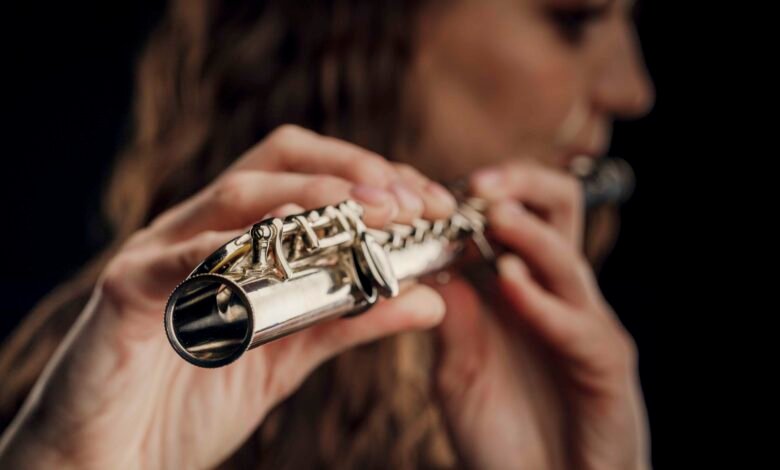What’s the Difference: flutist vs flautist

Do you know there’s a big debate about what to call someone who plays the flute? Some say flutist vs flautist while others prefer “flautist.” Let’s find out why this argument exists and what it’s all about.
In the world of music, especially when it comes to playing the flute, there’s a funny thing about what to call the players. Imagine you’re in a music class and your teacher asks, “Are you a flutist or a flautist?” It can be confusing! But don’t worry, we’ll figure it out together.
What Does “Flutist” Mean
In the world of music, a “flutist” is someone who plays the flute. The flute is a beautiful instrument that makes sweet, high-pitched sounds. When you hear music that sounds light and airy, it might be a flutist playing! Flutists are skilled musicians who can make the flute sing with their fingers dancing on the keys. They practice a lot to play music that makes people feel happy and relaxed.
Flutists have been around for a long time. Did you know that the word “flutist” comes from an old English word? It first appeared way back in 1603! Since then, people all over the world have used this word to talk about flute players. So, next time you hear someone say “flutist,” you’ll know they’re talking about someone who plays the flute beautifully.
When you go to a concert and see someone on stage holding a long, slender flute, you can say, “That’s a flutist!” They might play classical music, jazz, or even pop songs with their flute. It’s cool to know about different musicians and what they do with their instruments, like the talented flutist.

What Does “Flautist” Mean
Have you ever heard someone being called a “flautist”? Well, a “flautist” is just another word for someone who plays the flute! It’s like having two names for the same job. When you hear the word “flautist,” you can think of someone who loves playing music with the flute. They use their breath to blow into the flute and their fingers to press the keys to make beautiful melodies.
The word “flautist” sounds fancy, doesn’t it? It comes from an Italian word “flauto,” which means flute. People started using “flautist” more in the 1800s, but before that, “flutist” was more common. It’s interesting how words change over time and how different people prefer different names for things.
Next time you listen to music and hear the sound of a flute, you can say, “That’s a flautist playing!” They might be playing in a band, an orchestra, or even by themselves to entertain people. Flautists are amazing musicians who bring joy to others with their flute music.
The History of the Flute Player Names
The history of what to call someone who plays the flute is quite fascinating. Back in the olden days, around 1400, people used to say “fluter” for someone who played the flute. It was a simple word that described what they did—fluting with the flute! As time passed, different words started popping up.
In the 1600s, “flutist” became a common word in English. It was used to describe someone who played the flute with skill and passion. People liked how it sounded and it stuck around for a long time. But then, in the 1800s, “flautist” entered the scene. It came from Italian, where they said “flautista” for flute players.
Nowadays, both “flutist” and “flautist” are used by people around the world. In America, you might hear “flutist” more often, while in Britain, “flautist” is quite popular. It’s like having two flavors of ice cream—you can pick your favorite, and both are delicious!
What Does a Flute Player Do
Have you ever seen someone play the flute? It’s like magic! A flute player makes music by blowing air into a long, thin tube with holes called a flute. They use their fingers to cover and uncover the holes to make different sounds. It’s a bit like playing a musical puzzle with your fingers!
Flute players practice a lot to get really good at making music. They learn how to read notes on a sheet of music and play songs that can make you feel happy, sad, or even want to dance! Sometimes they play by themselves, and other times, they play in a group with other musicians, like in a band or an orchestra.
In concerts, you might see a flute player standing on stage, holding their flute up to their mouth. They blow gently into the flute and move their fingers quickly across the keys to create beautiful melodies. It’s amazing how they can make music that fills the air and makes people smile!
Who Can Be a Flute Player
Anyone can learn to play the flute! You don’t have to be a grown-up or have special talents. Even kids like you can start learning to play the flute. All you need is a flute, some lessons to teach you how to play, and lots of practice!
Flute players come in all ages and from all over the world. Some start playing when they are very young, while others discover their love for the flute later in life. It’s never too late to learn something new and exciting like playing music with a flute!
When you become a flute player, you join a big community of musicians who love making music together. You can play different kinds of music—classical, jazz, folk, and even pop songs! Imagine being able to play your favorite songs on a flute and share your music with others. It’s a special feeling to be a flute player!

Why Do People Love Flute Music
Have you ever wondered why flute music sounds so lovely? It’s because the flute can make soft, gentle sounds that float through the air like a gentle breeze. When you listen to flute music, it can make you feel calm and happy inside.
Flute music has been around for a long time. People have been playing flutes for thousands of years! Back then, flutes were made from bamboo or wood, and they were used to play music for celebrations, ceremonies, and even just for fun.
Today, flute players use metal flutes that can make clear, beautiful sounds. They practice every day to get better at playing their flute and making music that everyone can enjoy. Whether you hear flute music in a movie, a concert, or even in a park, it’s sure to make you stop and listen.
Different Types of Flutes
Did you know that there are different types of flutes? It’s not just one size fits all! Flutes come in various shapes and sizes, each with its own special sound. The most common type you might see is the silver flute, which is used in orchestras and bands. It has a bright, clear sound that can be heard over other instruments.
Then there’s the piccolo, which is like a tiny flute! It’s much smaller than a regular flute and makes high-pitched sounds. Piccolos are often used to play solos or to add a sparkling sound to the music. Imagine a flute that can sing like a bird—that’s the piccolo!
Another type of flute is the bass flute. flutist vs flautist
much larger than a regular flute and has a deeper, richer sound. Bass flutes can play low notes that rumble like thunder or flow gently like a calm river. They add a lot of depth to the music and make it sound more full and complete.
No matter what type of flute you play, each one is special and unique. Flute players love exploring the different sounds they can make with their flutes and discovering new ways to express themselves through music. flutist vs flautist like having a whole world of music right at your fingertips!
Famous Flute Music Pieces
Have you ever wondered about the music that flutes play? There are many famous pieces of music that feature the flute as the star! One of the most famous flute pieces is “The Magic Flute” by Wolfgang Amadeus Mozart. It’s an opera where the flute music is like a magical spell that enchants everyone who hears it. Mozart was a genius composer who loved the flute and made flutist vs flautist shine in his music.
Another famous flute piece is “Flute Concerto in D” by Carl Philipp Emanuel Bach. This concerto is like a musical conversation between the flute and the orchestra. flutist vs flautist has fast and slow parts that show off the flute’s range of sounds and emotions. Bach wrote this concerto to show how beautiful and expressive the flute can be in classical music.
In modern music, you might hear flutes playing in pop songs, jazz bands, and even in movie soundtracks! Flute players can adapt to different styles of music and make their flute sound cool and groovy or soft and sweet. They practice a lot to play these famous pieces perfectly and bring joy to people who love music.
How Flutes Make Sound
Have you ever wondered how flutes make such beautiful music? flutist vs flautist all about air and vibrations! When a flute player blows air into the flute, the air splits into two streams inside the tube. One stream goes across the top of the flute’s hole, and the other goes across the bottom. This makes the air vibrate and creates sound waves that travel through the air and into our ears!
The size and shape of the flute affect the sound it makes. A longer flute makes lower sounds, while a shorter one makes higher sounds. Flute players use their fingers to cover and uncover the holes along the flute’s body. This changes the length of the air column inside the flute and makes different notes.
Flute players also use their breath to control the volume and tone of the music. They can blow softly to make quiet, gentle sounds or blow harder to make loud, powerful sounds. flutist vs flautist takes practice to learn how to control your breath and make the flute sing beautifully, but it’s worth it to hear the magic of flute music!
Flute Players Around the World
Flute players can be found in every corner of the globe, from big cities to small villages. They share a love for music and a passion for playing the flute. In India, you might hear the bamboo flute called the bansuri. flutist vs flautist has a sweet, mellow sound that is used in classical Indian music and folk songs. Bansuri players learn traditional melodies and techniques that have been passed down through generations.
In South America, the Andean flute called the quena is popular. flutist vs flautist made from wood or cane and has a haunting, airy sound that echoes through the mountains. Quena players use their breath to play melodies that tell stories of their culture and history. They often play in groups with other traditional instruments like drums and guitars.
No matter where you go, you can find flute players making music that brings people together and celebrates their heritage. They use their flutes to express emotions, share stories, and create connections with audiences around the world. Flute players are like musical ambassadors who spread joy and harmony through their music.
The Difference Between Flute and Piccolo
Have you ever wondered how the flute and piccolo are different? They may look similar, but they have distinct characteristics that make them unique instruments in the orchestra.
The flute is a longer instrument with a lower range of notes compared to the piccolo. flutist vs flautist made of metal or wood and has a mellow, sweet sound that can be heard over other instruments in an ensemble. Flute players use their fingers to cover and uncover the holes along the flute’s body, producing a variety of tones and melodies.
On the other hand, the piccolo is much smaller than the flute and is known for its high-pitched, bright sound. flutist vs flautist like a tiny flute but with a higher range of notes. Piccolo players blow air into a smaller tube with fewer holes, creating a sharp, piercing sound that adds sparkle to orchestral music.
In an orchestra, the flute and piccolo play different roles. The flute often plays melodies and harmonies that blend with other instruments, while the piccolo adds a distinctive sparkle to the music with its high, clear notes. Together, they create a balanced and beautiful orchestral sound that delights audiences around the world.

Conclusion
Now that we’ve learned all about flute players and their music, isn’t it amazing how one instrument can make so many different sounds? Whether they’re called flutists or flautists, these musicians bring joy and beauty to the world with their flute music. From classical concerts to movie soundtracks, the flute’s sweet melodies can touch our hearts and make us smile.
Next time you hear the sound of a flute floating through the air, remember all the hard work and passion that flute players put into their music. They practice every day to become better and share their love for music with everyone around them. So, let’s celebrate flute players for their talent and dedication to making the world a more musical place!
flutist vs flautist Keep listening to flute music and maybe even try playing the flute yourself someday. Who knows? You might discover a new love for music and become a flute player too! Music is a magical journey that brings people together, and flute players are the wizards who make that magic happen.



